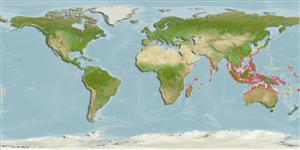Environment: milieu / climate zone / depth range / distribution range
Ecología
marino; salobre demersal; rango de profundidad 3 - 15 m (Ref. 90102). Tropical
Indo-West Pacific.
Tamaño / Peso / Age
Maturity: Lm ? range ? - ? cm
Max length : 10.2 cm SL macho / no sexado; (Ref. 1623)
Short description
Claves de identificación | Morfología | Morfometría
Espinas dorsales (total) : 6 - 7; Radios blandos dorsales (total) : 9 - 10; Espinas anales: 1; Radios blandos anales: 8 - 9. Characterized by semi-translucent grey body with brown and white spotting; lower side of body with row of double blackish spots; pelvic fins united and frenum present; rounded caudal fin, about equal to head length; longitudinal scale series 22-26; ctenoid body scales and on nape; predorsal scales 8-11; cheek and opercle without scales; depth of body 5.5-6.1 in SL (Ref. 90102).
Solitary or in small groups. Inhabits sand-rubble bottoms in 3-15 m (Ref. 90102).
Life cycle and mating behavior
Madurez | Reproducción | Puesta | Huevos | Fecundidad | Larva
Goren, M. and M. Dor, 1994. An updated checklist of the fishes of the Red Sea (CLOFRES II). The Israel Academy of Sciences and Humanities, Jerusalem, Israel. 120 p. (Ref. 12541)
IUCN Red List Status (Ref. 130435: Version 2024-1)
Threat to humans
Harmless
Human uses
Herramientas
Special reports
Download XML
Fuentes de Internet
Estimates based on models
Preferred temperature (Ref.
123201): 25.2 - 29.3, mean 28.6 °C (based on 2838 cells).
Phylogenetic diversity index (Ref.
82804): PD
50 = 1.0000 [Uniqueness, from 0.5 = low to 2.0 = high].
Bayesian length-weight: a=0.00692 (0.00374 - 0.01278), b=3.05 (2.89 - 3.21), in cm total length, based on LWR estimates for this species & (Sub)family-body (Ref.
93245).
Nivel trófico (Ref.
69278): 3.4 ±0.4 se; based on size and trophs of closest relatives
Resiliencia (Ref.
120179): Alto, población duplicada en un tiempo mínimo inferior a 15 meses (Preliminary K or Fecundity.).
Fishing Vulnerability (Ref.
59153): Low vulnerability (10 of 100).
